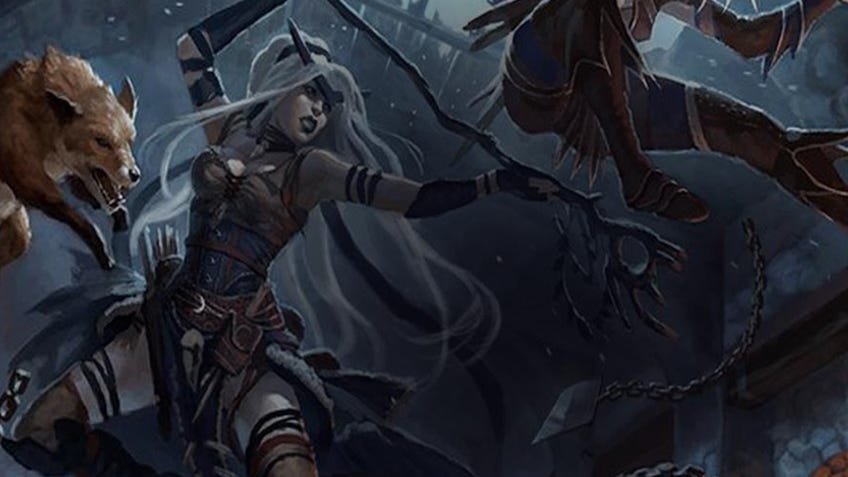Dungeons & Dragons 5E ranger class explained
Hunting for answers to what a ranger can do, how to create one and develop the ranger class further in Dungeons & Dragons 5E.
The ranger is the Bear Grylls of any Dungeons & Dragons 5E party. Grizzled and resourceful, capable of finding passable trails in otherwise treacherous landscapes, rangers bring a hefty amount of utility and customisation.
Rangers are an unusual type, which, when you think about it, is something you could say this about pretty much D&D 5E class. (Compare the options and learn how to pick your class in Dungeons & Dragons with our guide.) But rangers are genuinely weird when compared to their Dungeon & Dragons brethren, simply because they’re both incredibly customisable and yet quite streamlined.
- Choosing ranger skills and equipment: what proficiencies to give your ranger, as well as weapons and armour.
- Selecting a favoured enemy and terrain: what these unique ranger elements are and how to choose the best options for your ranger.
- How do rangers use magic in Dungeons & Dragons 5E?: rangers have a very specific way of using spells, find out how in this section.
- What is extra attack and how can rangers use it?: Extra Attack is one of a ranger’s most useful feats - learn more in this section.
- Using Primeval Awareness, Land’s Stride and Hide in Plain Sight: These are the quintessential powers that define the ranger class, find out how to use them in this section.
- Selecting a ranger archetype: these are the different paths that your ranger can take to further focus their abilities, decide which one to choose here.
- The Hunter archetype: a ranger archetype that focuses on monster slaying.
- The Beast Master archetype: a ranger archetype that enables you to tame creatures.
- What race should I play as a ranger?: What kid of races work with the ranger class and how to choose the right race in Dungeons & Dragons 5E
In concept, rangers are a bit like Batman as their character is entirely based around their chosen nemeses’. This is also what makes the ranger a particularly strange class to create, as they have the opportunity to choose loads of little quirks focused around whatever creature they’re most obsessed with defeating. This may make rangers seem very limited, but they also get a whole smorgasbord of talents, skills and even spells on top of all this - which you can learn to use with our guide to the basics of Dungeons & Dragons.
So enough philosophising. Let’s get into what is actually involved in making a D&D 5E ranger.
Choosing ranger skills and equipment

Despite being one of the more limited Dungeons & Dragons classes when it comes to weapon proficiencies, rangers still get a nice mixture of equipment to choose from at first level. If the word ‘proficiencies’ is coming up with a blank, then we recommend you have a look at our guide to Dungeons & Dragons 5E terms explained.
Before we dig our hands into the pile of ranger equipment you get to choose from, we need to decide which of the beginning skills you want your character to have proficiency in. You’ll get to pick three skills from a list of animal handling, athletics, insight, investigation, nature, perception, stealth and survival.
Whichever you choose entirely depends on the flavour of ranger you’re aiming to create. Are they a friend to all animal kind and a master of mother nature’s fine bounty? Then the animal handling and nature skills should most definitely be included in your chosen three. Or how about a ranger that confidently bounds through forests hot on the trail of some sort of rapid beast? Taking the athletics and survival skills are guaranteed to get them on the path towards this dream.
Once you’ve got your chosen proficiencies down, you can get stuck into the ranger’s starting equipment. It’s arguably one of the most well-balanced groups of equipment sets in Dungeons & Dragons 5E, with a varied mix of armour, weapons and packs. Choose between the (a) and (b) options of each set, with the last being mandatory (because every ranger needs a longbow). What you decide on will likely be driven by which of the upcoming fighting styles you want your ranger to adopt, and if you want them to embrace manoeuvrability over resilience. Other than this, you’ll be selecting between a dungeoneer’s or explorer’s pack, which contain rather similar items, aside from some differences in tools over comforts. If you plan on breaking in anywhere, then pick the dungeoneer’s, otherwise the explorer’s pack is probably a damn sight more useful.
Selecting a favoured enemy and terrain
This is where the ranger weirdness really begins to kick off. You’ll select what’s known as a favoured enemy from the available options on page 91 of the Dungeons & Dragons 5E Player’s Handbook, which are roughly the kind of aggressive groups you might face throughout your journey. You’ll likely find more information on each of these groups in the Player’s Handbook or many of the other sourcebooks for Dungeons & Dragons 5E. Your ranger’s favoured enemy can be decided by a number of factors, including the idea that they simply hate that kind of creature (it is hard to love an ooze). Another approach is to simply ask what setting your DM intends to run your campaign in, and do a little research into what kind of creatures might dwell in such a place.
You can take a similar approach to selecting your favoured terrain with the Natural Explorer talent; either pick an environment that would likely appear in the setting of your upcoming campaign, or one that would make sense in the context of your character.

Favoured Enemy and Natural Explorer are both entirely unique to the ranger class in D&D 5E, and don’t really involve any of the usual elements seen in most talents. The Favoured Enemy talent gives you advantage on wisdom ability checks whenever you want to track that particular type of creature. Alongside advantage on any time you want to roll an intelligence ability check to recall information about that creature. What is advantage and what are ability checks? They’re fundamental gameplay concepts featured in our guide to the basics of Dungeons & Dragons, which should clear any potential confusion.
The Natural Explorer talent is even weirder than Favoured Enemy, as it provides a wide variety of general benefits you can expect to receive whenever you happen to come across the particular terrain you’ve chosen. These include not getting lost (except through magical means), finding more food whenever you forage, and not being slowed by difficult terrain (image heavy mud and the like).
How do rangers use magic in Dungeons & Dragons 5E?
Despite not being primarily a spellcasting class, all rangers gain access to a list of spells at second level. These spells exist in their own subclass of ranger spells, which means that you will be limited to only casting spells from this list.
As rangers are not a spellcasting class, their spellcasting ability is derived directly from their wisdom ability score rather than a spellcasting ability score as it is with wizards, sorcerers, and the like. Ability scores are hashed out in our Dungeons & Dragons 5E character creation explained guide, so hop there if you want to work out what your wisdom score might be.
You begin second level with just two first level ranger spells, but this total slowly increases as and when you level up.
If you were interested in learning more about spellcasters, then how about having the Dungeons & Dragons 5E wizard class explained?
What is Extra Attack and how can rangers use it?
Extra Attack is gained by rangers at fifth level, and simply put, enables them to attack twice in a single round, rather than just once. This talent can be used once per combat round, and can be stacked with any other spells or abilities that otherwise allow your ranger to attack more than once.
If you want to learn more about combat rounds, then have a read of our guide to the basics of Dungeons & Dragons.

Using Primeval Awareness, Land’s Stride and Hide in Plain Sight
As your ranger continues to level-up, they’ll gain access to a few more neat little talents to help improve their tracking and stealth abilities.
The first of these is the Primal Awareness talent, which also happens to tie into your spellcasting ability. By expending one of your spell slots, your ranger will acquire a sort of sonar sense to detect whether any creatures of a certain type are in the surrounding area.
The second of these talents is Land’s Stride, which you’ll gain at eighth level. Land’s Stride makes you immune to any slowing effects caused by difficult terrain and any non-magical plantlife; think tangled vines or particularly vicious thorns.
The final of these talents is Hide in Plain Sight, which takes your ranger’s ability to blend into their natural surroundings beyond the figurative. With Hide in Plain Sight, your ranger will be able to camouflage themselves using resources found around them, Predator-style. This will give you a +10 bonus to stealth checks whenever your ranger attempts to hide in that environment.
Selecting a ranger archetype
Whereas most D&D 5E classes get to choose between at least three different variations of their character build, rangers only get the two. At least, when it comes to the content featured in the Dungeons & Dragons 5E Player’s Handbook. There are, of course, several ranger archetypes out there, including those featured in various other sourcebooks for Dungeons & Dragons 5E. However, for this guide we’re going to stick to those options found in the Player’s Handbook
.Luckily enough, these two archetypes are different enough that rangers aren’t really missing out by not having a third option. The Hunter archetype is all about expanding your ranger’s existing specialisations, mainly the Favoured Enemy talent, into an even deadlier arsenal of monster-killing abilities. Whereas the Beast Master archetype takes your ranger down an entirely new route, one that involves taming powerful creatures and setting them on your enemies.
The Hunter archetype
Taking the Hunter archetype will turn your ranger into the ultimate monster slayer, with talents to significantly improve their combat capabilities.
You’ll get your first combat talent as soon as you take up the archetype, with the Hunter’s Prey selection. This particular chocolate box of combat options includes a talent for each flavour of encounter, whether you’re facing an enormous beast, a towering giant or a swarm of minions. You’ll get to choose from three great abilities, depending on which of the above encounters your ranger is most prone to stumbling into. We have to say that Colossus Slayer is particularly good, as it can apply to any enemy, as long as they’re currently below their hit point maximum (meaning, as long as they’ve taken damage).
Whereas, the next toolset you’ll get to pick from is more defense-based, with nifty little talents saving you from nasty status effects and attacks of opportunity. Again, your decision is dependent upon what situations you want to give your ranger a helping hand in. Admittedly, the Multiattack Defense talent works especially well when tackling enemies with a larger pool of hit points, as it gives your ranger a +4 bonus to their AC whenever you face an attack from something that’s hit you on a previous occasion. (Want to know how to calculate your AC? Head over to our guide to Dungeons & Dragons 5E character creation explained.)
Whichever talents you choose next, will be decided by your ranger’s chosen weapon and general approach to combat. If they use a ranged weapon, then take Volley; if they use a melee weapon, take Whirlwind Attack.

The Beast Master archetype
Taking the Beast Master archetype sends your ranger down a completely different route.
Yes, that’s right. Animal companions.
Rangers who adopt the Beast Master archetype gain the ability to tame a beast of your choosing, as long as it’s no larger than medium sized and isn’t higher than a challenge rating of one quarter. This essentially means that your ranger gets their very own Toto-slash-Battle Cat to travel around with them, just as long as they don’t pick anything too enormous or overpowered. You can find a lot of potential candidates for your animal companion in either the Dungeons & Dragons 5E Dungeon Master’s Guide or the Dungeons & Dragons’ Monster Manual, alongside their associated stats, size and difficulty rating.
What can your animal companion do besides look really cute and awesome? Well, they essentially become another member of your D&D party; using your proficiency bonuses for their modifiers, they’ll be able to take their own combat turn and perform their own actions independently from you. During combat, you’ll be able to command it to take one of the major actions available to it (attack, dash, disengage or help), and even if your ranger is incapaciated or otherwise out-of-action, then your animal companion can keep fighting.
As you level-up, your animal companion will gain new talents that allow it to attack multiple times during its turn and your turn.
What race should I play as a ranger?
Which races work best for the ranger class has been lightly covered by our guide to how to choose the right character race in Dungeons & Dragons 5E, which is a great resource if you want to peruse D&D’s various available races. In the interests of streamlining your character creation experience, we’re going to cover the subject in a little more detail here.
With their lithe frames and gentle footsteps, elves are generally a good shout for classes that thrive on dexterity. Benefitting from a dexterity score increase, having darkvision, and a proficiency in perception, makes elves rather perfect for skulking around nature’s highways. This especially goes for wood elves who, with their Fleet of Foot trait and ability to hide in bad weather, makes them particularly manoeuvrable in natural environments.

Dexterity comes in handy once again with the halfling race, who not only get an increase to their DEX ability score, but also benefit from the nimbleness trait (which allows them to move through spaces containing larger creatures). They’re also surprisingly good damage dealers, as they have the ability to re-roll any ones on attack rolls.
It seems that most good things do come in small packages, as gnomes are also a brilliant choice of race for the ranger class. Alongside the ever-useful trait of Darkvision, gnomes also get advantage on all charisma, wisdom and intelligence saving throws, which is an especially beneficial when fighting against monsters that may attempt to put status effects on you. The forest gnome is a particular good choice when creating a ranger, as they get an increase to their dexterity ability score.
That’s pretty much a wrap on how to create your perfect ranger, but if you’re curious about what other classes D&D has to offer, then you can find everything you need to know in our guide to how to pick your character class in Dungeons & Dragons 5E. Maybe you want to be a rogue? Perhaps have a look at our Dungeons & Dragons 5E rogue class explained. Or if you fancy making a fighter, then have a read of our guide to Dungeons & Dragons 5E fighter class explained.









